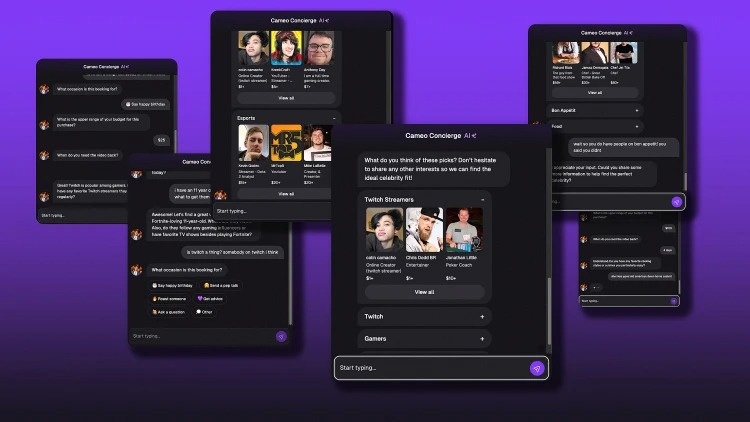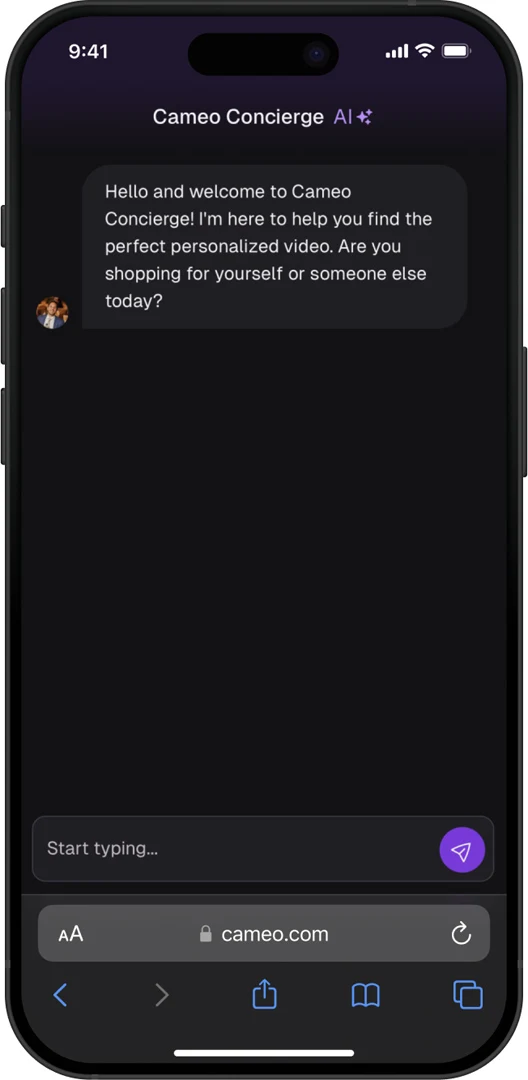- | 8:00 am
Cameo introduces new gen AI search to help you find the perfect celeb for your message
With 50,000-plus celebrities on the platform, Cameo’s new beta AI search shows how services are using generative AI to solve UX pain points—even if the tech doesn’t live up to its promise.

Cameo—the hire-a-celebrity-to-talk-to-my-friend service—has a new way to search for the perfect person to record a clip. And, yes, it involves natural language search courtesy of generative AI.
Now users who find themselves a bit lost on Cameo will automatically see a pop-up assistant offering help as part of a beta launch. If they’d like, they can enter an AI chat to help find the right celebrity for the job.

In recent years, Cameo has struggled to live up to its unicorn ambitions, but it’s still extraordinarily popular, with 50,000 celebrities and influencers of various scale on the platform. As Dom Scandinaro, CTO at Cameo, explains, with such a large inventory of people, it’s getting harder to find the right person you want to hire. That issue is exacerbated by the fact that 80% of Cameos are a gift for another person—meaning Cameo can’t simply profile your own tastes and, in fact, its own shoppers might be a bit clueless as to that exact singer, athlete, or actor they are looking for.
“[Discovery] is a pretty big part of the platform,” says Scandinaro. “We’re just very bad at it today, I would say.”
That leaves opportunity for companies like Loka, which is something of a gen AI fixer, to step in and help—as it did with Cameo. In the past few years, Loka has launched hundreds of projects for companies with backgrounds ranging from entertainment to healthcare to energy. As a close (but not exclusive) partner of Amazon Web Services, Loka works as a technical and UX consultant, bridging a company’s data stored in the cloud and the AI models that can best utilize it. With Loka, Cameo was able to integrate its data stored in the cloud with multiple LLM models to test.
“I think it’s somewhat straightforward to, you know, point a model at some set of data, ask some questions about it and get an okay answer. But I think if you’re really looking for something that’s more nuanced, more personalized to a situation, and not something that every way you ask the question, you might get the same outcome,” says Emily Kruger, chief innovation officer at Loka. “That requires a lot of iteration.”
In theory, I understand everything that Cameo and Loka are saying. LLMs can be surprisingly difficult to wield—even Google’s search results are iffy. But in practice, what the team has launched on Cameo today doesn’t seem to improve on the search bar.

I tried out a couple of conversations—posing as a dumb dad trying to find the right influencer on Twitch for my child, or a clueless husband wanting to find a cookbook star to record a message for my spouse. What I found was that the conversation felt extremely on rails—rather than really digging into someone’s interests or trying to figure out the celebrities I might be attempting to describe, it asked where my giftees were from and pushed me quickly to the amount I wanted to spend and how quickly I needed my recording done. Results were generic, and no better or faster than what I could find directly in search. I was particularly put off when I mentioned that I wanted someone who worked for NYT Cooking or Bon Appétit. The AI insisted it didn’t have anyone from Bon Appétit. In fact, Cameo does. You had one job, Cameo AI!

This tool might be fine if it were a chatbot out of 2018. Reasonably disappointing. I think the problem is that, with services like ChatGPT and Perplexity setting such a high standard for conversation, discovery, and search—even when wrong—anything short of that execution feels extraordinarily antiquated. It’s like how once you take a bite of really good dark chocolate, a Hershey’s bar never tastes the same again.
I don’t point this out as a slight; I point this out because it’s evidence that AI might not be the solution for your company’s biggest design problem, and that for AI to really move the needle on experience, we need to continue to think beyond the prompt altogether.
“I think for us, you know, we’re not in the business of healthcare or finance, so we have a little bit more flexibility to to ship stuff quickly, to learn to be okay with you know, 80% of the experiments we run failing to to find the 20% that’ll be really successful for us quickly,” says Scandinaro.
The good news is that, indeed, this is a low-stakes application, and I have little doubt that Loka and Cameo will get this experience working better over time. But until then . . . there’s always good old traditional search.





































